Wind Turbine Rotor Blade with Varying Blade Depth
- Summary
- Abstract
- Description
- Claims
- Application Information
AI Technical Summary
Benefits of technology
Problems solved by technology
Method used
Image
Examples
Embodiment Construction
[0036]The wind turbine rotor blade 10 shown in FIG. 1 comprises a blade root 12 and a blade tip 14. At the blade root 12, the wind turbine rotor blade 10 has an essentially circular cross section and is configured for attachment to a rotor hub which is not shown. For example, for this purpose it comprises a flange that is also not shown in the figure. The circular cross section at the blade root 12 transitions into an aerodynamic profile with increasing distance from the blade root 12.
[0037]The rotor blade has a maximum blade depth 18 at a first longitudinal position 16. In the embodiment shown, this amounts to approximately 3.3 m. The blade length 20 of the rotor blade shown is approximately 42 m.
[0038]Furthermore, FIG. 1 shows an outer longitudinal section 22, a middle longitudinal section 24 and an inner longitudinal section 26. The outer longitudinal section 22 extends over 20% or more of the blade length 20. The blade depth is in the range from 20% to 30% of the maximum blade d...
PUM
 Login to View More
Login to View More Abstract
Description
Claims
Application Information
 Login to View More
Login to View More - Generate Ideas
- Intellectual Property
- Life Sciences
- Materials
- Tech Scout
- Unparalleled Data Quality
- Higher Quality Content
- 60% Fewer Hallucinations
Browse by: Latest US Patents, China's latest patents, Technical Efficacy Thesaurus, Application Domain, Technology Topic, Popular Technical Reports.
© 2025 PatSnap. All rights reserved.Legal|Privacy policy|Modern Slavery Act Transparency Statement|Sitemap|About US| Contact US: help@patsnap.com



